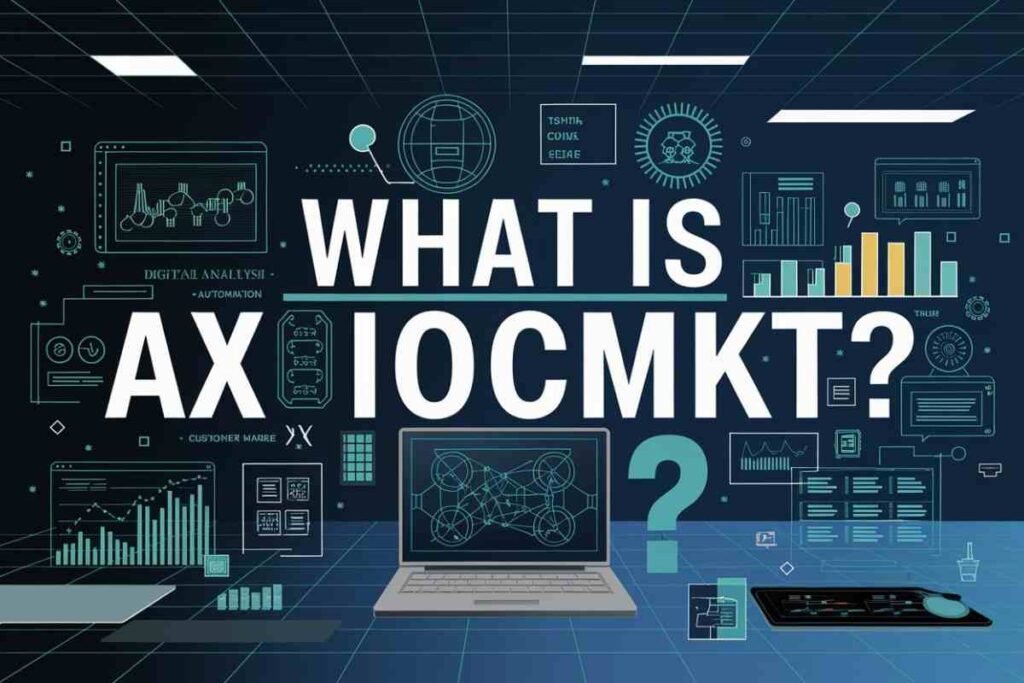The term Ax iocmkt might sound technical, but it is an essential tool for businesses aiming to optimize their marketing strategies and operational workflows.
This concept has grown in importance, helping organizations streamline processes, improve customer engagement, and increase profitability.
In this detailed guide, we’ll explore 7 proven strategies , its benefits, challenges, tools, and the future of this impactful methodology.
What is Ax iocmkt?

At its core, refers to the alignment of marketing and operational strategies through innovative tools and frameworks.
It emphasizes seamless data integration, advanced analytics, and process optimization to achieve better results. For instance:
- Ax: Refers to advanced execution.
- Iocmkt: Stands for integrated operations and customer marketing technology.
When implemented effectively, Ax iocmkt improves business agility, enhances decision-making, and fosters customer-centric solutions.
Why Ax iocmkt Matters in Business
The significance of Ax iocmkt lies in its ability to bridge the gap between marketing and operational teams. Here’s why it is vital:
- Streamlined Communication: Breaks silos between departments.
- Enhanced Analytics: Offers data-driven insights for better planning.
- Customer-Centric Focus: Enables more personalized and impactful marketing campaigns.
How to Implement Ax iocmkt Successfully
Implementing Ax iocmkt successfully requires a strategic approach that ensures alignment between marketing operations and overall business goals. Below is a detailed guide to streamline the process:
Understand the Core Objectives
Begin by defining clear objectives for adopting. These could include:
- Enhancing customer engagement.
- Streamlining internal operations.
- Improving marketing ROI through data-driven strategies.
Establishing measurable goals ensures clarity and direction for the implementation process.
Audit Existing Systems and Processes
Analyze your current operational workflows, tools, and marketing strategies. Identify inefficiencies, bottlenecks, and redundancies that Ax iocmkt can address.
- Use SWOT analysis to highlight strengths, weaknesses, opportunities, and threats in existing processes.
- Map out the customer journey to identify areas where integration could enhance the experience.
Select the Right Tools and Platforms
Choosing appropriate tools is critical for successful implementation. Focus on platforms that support integration, automation, and analytics.
- Customer Relationship Management (CRM) Systems: Tools like Salesforce and HubSpot facilitate marketing and sales alignment.
- Marketing Automation Tools: Platforms like Marketo or Zoho Campaigns simplify repetitive tasks.
- Analytics Software: Tools like Tableau or Google Analytics provide actionable insights for decision-making.
Ensure these tools are compatible with your existing infrastructure to avoid integration challenges.
The Key Benefits of Ax iocmkt
Adopting Ax iocmkt has numerous advantages that directly impact business outcomes:
- Increased Efficiency: Reduces time spent on manual tasks by automating repetitive processes.
- Better Decision-Making: Access to real-time data improves forecasting and strategic planning.
- Cost Savings: Eliminates redundant efforts and optimizes resource allocation.
- Scalability: Easily adapts to new challenges and market dynamics.
Common Challenges and How to Overcome Them

Implementing Ax iocmkt comes with its own set of challenges. However, understanding these issues and preparing for them can ensure smoother adoption.
Difficulty in Integrating Existing Systems
Many businesses struggle to connect Ax iocmkt tools with their current systems. Legacy software may not support modern integrations, leading to inefficiencies.
- Solution:
- Choose tools designed for compatibility with older systems.
- Use middleware or APIs (application programming interfaces) to act as a bridge between old and new systems.
- Work with IT professionals to plan the integration process step by step.
Resistance to Change
Employees may feel overwhelmed or hesitant about adopting new workflows and technologies. They might worry about the complexity or fear losing their jobs due to automation.
- Solution:
- Communicate the benefits clearly, emphasizing how it will simplify their tasks rather than replace them.
- Provide hands-on training and continuous support to build confidence.
- Encourage feedback and actively address concerns to ensure a smooth transition.
High Initial Costs
Implementing Ax iocmkt tools and training can seem expensive, especially for small businesses with limited budgets.
- Solution:
- Start small by focusing on the most critical areas for improvement.
- Invest in scalable tools that can grow with your business.
- Look for subscription-based solutions to spread out costs over time.
Top Tools for Ax iocmkt
Numerous tools support Ax iocmkt implementation. Here are a few notable ones:
- HubSpot CRM: Offers marketing automation and integration features.
- Zoho Campaigns: Great for email marketing and data analysis.
- Tableau: Helps visualize complex data for better insights.
These tools make it easier to align operational processes with marketing objectives, resulting in better outcomes.
The Role of Ax iocmkt in Digital Transformation

In today’s rapidly evolving digital world, it plays a crucial role in helping businesses stay competitive and relevant.
Digital transformation is all about leveraging technology to improve business operations, customer experiences, and decision-making processes. Here’s how contributes to this journey:
Bringing Teams Together
One of the biggest hurdles in digital transformation is the lack of collaboration between different departments. It bridges the gap between marketing, operations, and customer service teams by integrating tools and processes. This alignment ensures everyone works towards common goals, creating a unified approach to business growth.
Improving Agility and Flexibility
In a fast-paced market, businesses need to adapt quickly to new trends and customer demands. Marketing efficiency provides real-time data and insights, allowing companies to respond promptly.
For example, marketing campaigns can be adjusted on the go, and operational workflows can be streamlined to meet changing demands.
Enhancing Customer Experience
Digital transformation focuses heavily on improving how businesses interact with their customers. With marketing automation companies can personalize their marketing strategies, offer tailored solutions, and provide seamless support. This customer-centric approach not only increases satisfaction but also builds long-term loyalty.
Conclusion
Mastering Ax iocmkt has become essential for businesses that want to stay competitive in today’s fast-paced market.
By fully understanding its key concepts and applying the strategies outlined in this guide, businesses can significantly enhance operational efficiency, boost customer satisfaction, and drive long-term growth.
Embracing Ax iocmkt helps businesses integrate their marketing and operations seamlessly, improving decision-making and adaptability. The benefits are clear—greater efficiency, cost savings, and a stronger market position.
FAQs
What is Ax iocmkt?
Ax iocmkt refers to the integration of marketing and operational strategies to enhance efficiency and effectiveness.
Why is Ax iocmkt important?
It helps businesses streamline processes, improve customer engagement, and achieve better results.
How do I get started with Ax iocmkt?
Begin by assessing your current systems, choosing the right tools, and training your team on their usage.
Which industries benefit from Ax iocmkt?
Industries like retail, finance, technology, and healthcare can benefit significantly.
What are the main challenges of Ax iocmkt?
Common challenges include integration difficulties, resistance to change, and data privacy concerns.
Are there specific tools for Ax iocmkt?
Yes, tools like HubSpot, Zoho Campaigns, and Tableau are designed to support Ax iocmkt implementation.
How does marketing automation improve business efficiency?
Marketing automation streamlines repetitive tasks like email campaigns, social media management, and customer segmentation.